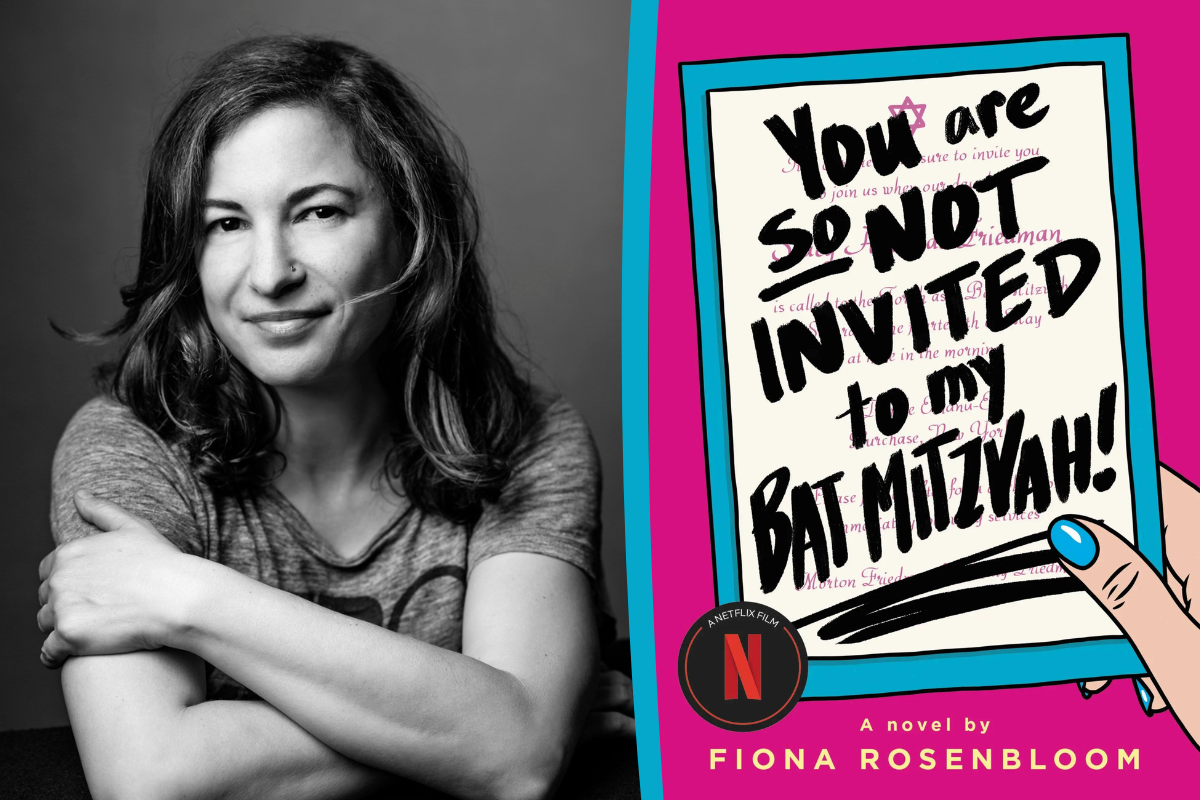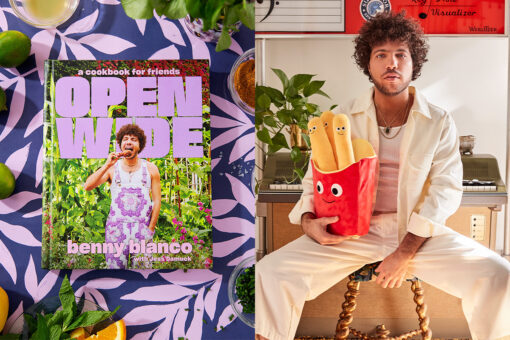When I was a kid, Fiona Rosenbloom was to me what Judy Blume was to most everyone else. Sure, I enjoyed “Are You There God? It’s Me, Margaret” and the “Super Fudge” series, but nothing, and I mean nothing, could compare with Rosenbloom’s 2005 book “You Are SO Not Invited to My Bat Mitzvah.”
The novel (yes, I am aware it’s a children’s book, but to me, it is hard literature) focuses on Stacy Friedman, a 12-year-old in 2005, as she prepares for her upcoming bat mitzvah. At the same time, she has to deal with her parents’ recent separation, her nerdy brother Arthur’s social awkwardness and, oh yeah, her traitorous best friend, Lydia Katz, totally stealing her crush, Andy Goldfarb.
“Much like ‘The Great Gatsby’ or ‘Middlemarch’, ‘You Are SO Not Invited to my Bat Mitzvah’ is a masterpiece of its time,” I wrote for Hey Alma in 2021. Later, for Kveller, I added, “I read and reread the book feverishly, finding the everyday, casual representation of Jewishness heartening and the teenage girl drama delicious. ‘You Are SO Not Invited to My Bat Mitzvah’ represented, simultaneously, everything my life was and everything I wanted my life to be as a young Jewish tween in the mid-late 2000s.”
So, when the news came out last summer that 1) “You Are So Not Invited to My Bat Mitzvah” was being adapted into a Netflix movie starring Adam Sandler and his family, Idina Menzel and Sarah Sherman, 2) the book was being updated and re-released in coordination with the movie and 3) Fiona Rosenbloom is the nom de plume of author Amanda Stern, I experienced a wide range of emotions in rapid succession.
I was thrilled for my inner child who had yearned for a “You Are So Not Invited” movie, and for the new generation of young Jewish readers with whom it would certainly resonate; I was slightly jealous that this hadn’t happened sooner; I felt a duty to explain to all my non-Jewish friends just how big of a deal this was; and I felt a curiosity about the true identity of the book’s author.
I also couldn’t help but be nervous about how the movie would handle the character of Andy Goldfarb, a white Ashkenazi Jewish boy from privilege who appropriates Black language and culture. (We’re not supposed to root for Andy, but would tween viewers of an Adam Sandler film get that?) Similarly, I was intrigued about how Amanda might or might not edit Andy to update him for our world of heightened identity politics and cancel culture.
While Amanda is not answering questions about the upcoming “You Are So Not Invited to My Bat Mitzvah” movie out of solidarity with striking WGA and SAG-AFTRA workers, we sat down to chat about updating her 2005 book for 2023 and a shocking revelation about her own bat mitzvah.
This interview has been lightly edited and condensed for clarity.
Because the book is about bat mitzvahs, can you tell me a little bit about your own bat mitzvah?
Yes, I can tell you everything about my bat mitzvah and the fact I didn’t have one.
Oh, wow.
I know. It’s the big surprise. I grew up secular Jewish. We didn’t have any sort of faith or religion or spirituality in my house at all. So I grew up going to bat mitzvahs and bar mitzvahs but I didn’t have one. My mom had a baby when I was 16, and she had a bat mitzvah. But I think it had less to do with religion and belief than everyone else was doing it and she wanted to.
In writing the book, did it kind of feel like giving yourself a bat mitzvah?
No, it didn’t. But it was a good insight into what I would have gone through had I had a bat mitzvah. I got a clinical look at the trials and tribulations of what it would be like. But also, by the time I was writing it, everything in the bat mitzvah universe was so heavily bent on marketing to consumerism. So I wasn’t even sure what I would have done. I guess I would’ve had a huge party.
So, since you didn’t have a bat mitzvah, what research went into writing the book?
It was so long ago that I don’t remember everything. But the thing that most fundamentally influenced and helped me was my best friend at the time. She grew up in a fairly religious household in Scottsdale, Arizona, and her parents had kept all of her preparation and everything. So we flew to Arizona so that I could talk to her parents and I could go look through her bat mitzvah notebooks and folders and a box of sentimental things from that time. That was really helpful, because I didn’t even go to Hebrew school. It really helped me flesh out some of the gaps.
Why did you use a pen name for “You Are SO Not Invited” and its sequel, “We Are SO Crashing Your Bar Mitzvah?”
I was approached to write these books – it wasn’t initially my idea. My first novel, “The Long Haul,” had just been published in 2003. My vision for myself and for my career was as a serious literary fiction writer, and writing kids books had never been anything I’d planned on doing. So when I was approached by Judy Goldschmidt from Alloy Entertainment, she was persistent in the best way and sort of pushed me to write a sample, which I did. And as soon as I started writing it, I was like, “Oh, wait a minute, this is joyous.”
For me, there was a sense that I would be pigeonholed if I used my actual name for the kids books. And that it would confuse the audience that I wanted for my literary fiction career. So it was sort of a preemptive strike against getting pigeonholed. I’m glad I did it. I think it’s still confusing for people to make sense of a writer who writes a bunch of different genres, though I think writers get it.
OK, so what was it like updating the book?
I did want to address the points brought up in your criticism [about Andy Goldfarb]. But Alloy Entertainment originally really wanted mention of products and celebrities that were important, and that wasn’t necessarily my impulse, so I had to update the references. I had to do a lot of research about those; I am now not as connected as kids are to the cultural influences of now. But the best part for me in updating it was that I had the most fun with Arthur. I don’t know why. But weirdly it felt a lot more fun this time. It felt like there was less at stake. Getting to write things that are sort of off brand for me — Amanda Stern — was uplifting and refreshing. It was a good time.
It’s interesting that your impulse with the first edition of the book wasn’t to include celebrities and pop culture references because now I think it serves as such a great time capsule of the mid-2000s. And I’m sure the same will be true of the updated version. But it also serves as a time capsule of not great things from then and now, and so I appreciated how you handled Andy Goldfarb and didn’t sanitize him.
Oh good. I’m really happy to hear that. I wasn’t entirely sure what was missing for you, but I did want to address your criticism, because I thought it was really valid. Even if it’s one person out of 100, it’s still valid. And I did grow up around a lot of white kids co-opting Black street style and AAVE and things like that. So, yes, it’s all about context and geography. To me, it was just painfully obvious that Andy Goldfarb was a fraud, basically.
Agreed. I think as a kid, I just so heavily identified with Stacy that it was hard for me to remove myself from her mindset that Andy is just the greatest, coolest guy ever. Which clearly isn’t true.
I understand now, and I don’t think I appreciated then, that the audience I was writing to was so much younger and maybe they couldn’t make the same leap that I was making.
It’s interesting because I think my opinion has slightly changed on it too. I wrote that critique a year ago, but actually I give more credit to kids now. Even though it was hard for me, I think they can make that leap. Would you consider updating or rewriting the sequel?
Oh, yeah. Definitely. When I was working on the book this time around, I got so into Arthur. I don’t know what happened. I’m so in love with him. Not only do I want to do the sequel, I want to write something like “Arthur Friedman Saves the World.”
Oh, I would love that.
I had this whole idea about a series where Arthur solves climate change. If anyone can do it, it’s him. And Greta Thunberg.
Agreed. Was Stacy modeled after you in any way?
Not really? While she’s not that confident, she has more confidence than I did. And she’s also – I mean, all tweens and teenagers are self-centered. So I think that in that way, yes. I was very self-centered because I didn’t have, and kids don’t have, perspective or concept of a world from any other point of view than their own. So in that way, yes, Stacy was modeled after me when it came to my tween egotism, but in other ways, no.
Honestly, I constructed her out of parts of me, parts of my nieces, parts of my imagination. I really wanted her to just be her own character and her own imaginary being separate from me or anyone recognizable in my life. I think it was much easier for me to do that with the kids than it is with adult characters.
Do you have any other upcoming projects or things that you’re writing?
It’s all adult stuff. I’m working on a novel for adults, and I’m working on a coffee table book. I’m applying for a ton of fellowships and grants which is a job unto itself. And I’m working hard on my newsletter, but I’m always five projects into something. I can’t just focus on one thing. But I will say that “Arthur Friedman Saves the World” is definitely percolating in the back of my head and if anyone wants me to do it, I will do it.
I would very much read that.
I want him to go to summits and climate forums. I want him to solve climate change. But, of course, in order to do that I would have to solve climate change…
Even if that particular aspect didn’t happen, I would love more of his quirky mannerisms or things he says. Like when Lydia calls Stacy, but she doesn’t want to talk to Lydia so Arthur answers the phone…
And he tells Lydia that Stacy donated her skin to science and needs to aerate.
Yes, exactly.
It’s so fun and joyous to write like that. That would never come into my head in any other context. There’s a freedom and a weird opening in my brain that happens when I write these books. It’s a little form of therapy.



